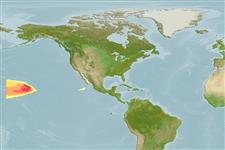Classification / Names
Common names | Synonyms | Catalog of Fishes(genus, species) | ITIS | CoL | WoRMS | Cloffa
Teleostei (teleosts) >
Stomiiformes (Lightfishes and dragonfishes) >
Stomiidae (Barbeled dragonfishes) > Melanostomiinae
Etymology: Eustomias: Greek, eu = good + Greek, stoma = mouth (Ref. 45335); problematicus: Named in reference to the initial enigma posed by its short branches (Ref. 45801).
Environment: milieu / climate zone / depth range / distribution range
Ecology
Marine; bathypelagic; depth range 0 - 800 m (Ref. 45801). Deep-water
Eastern Central Pacific: near Hawaii and from one station about 5 degrees south of Hawaii.
Size / Weight / Age
Maturity: Lm ? range ? - ? cm
Max length : 13.8 cm SL (female)
Short description
Morphology | Morphometrics
Barbel with three small unpigmented branches arising from stem; medial branch length less than 20% of distal barbel; lateral branch lengths less than 50% of distal barbel; distal tip of terminal bulb with two prominent medially based filaments each with numerous small, short side filaments; a similar, shorter filament and several simple filaments ventral to these (Ref. 45801).
Epi- and mesopelagic (Ref. 58302).
Life cycle and mating behavior
Maturity | Reproduction | Spawning | Eggs | Fecundity | Larvae
Clarke, T.A., 2001. Pelagic fishes of the genus Eustomias, subgenus Dinematochirus (Stomiidae), in the Indo-Pacific with the description of twelve new speices. Copeia 2001(3):683-699. (Ref. 45801)
IUCN Red List Status (Ref. 130435)
Threat to humans
Harmless
Human uses
More information
Common namesSynonymsMetabolismPredatorsEcotoxicologyReproductionMaturitySpawningSpawning aggregationFecundityEggsEgg development
Age/SizeGrowthLength-weightLength-lengthLength-frequenciesMorphometricsMorphologyLarvaeLarval dynamicsRecruitmentAbundanceBRUVS
ReferencesAquacultureAquaculture profileStrainsGeneticsElectrophoresesHeritabilityDiseasesProcessingNutrientsMass conversion
Tools
Special reports
Download XML
Internet sources
Estimates based on models
Preferred temperature (Ref.
123201): 5.6 - 14.1, mean 7.8 °C (based on 4 cells).
Phylogenetic diversity index (Ref.
82804): PD
50 = 0.5000 [Uniqueness, from 0.5 = low to 2.0 = high].
Bayesian length-weight: a=0.00302 (0.00117 - 0.00783), b=3.12 (2.89 - 3.35), in cm total length, based on LWR estimates for this (Sub)family-body shape (Ref.
93245).
Trophic level (Ref.
69278): 4.2 ±0.8 se; based on size and trophs of closest relatives
Resilience (Ref.
120179): High, minimum population doubling time less than 15 months (Preliminary K or Fecundity.).
Fishing Vulnerability (Ref.
59153): Low vulnerability (10 of 100).
